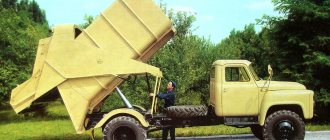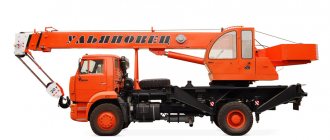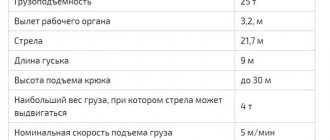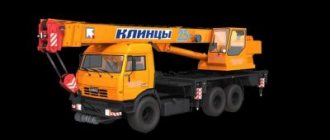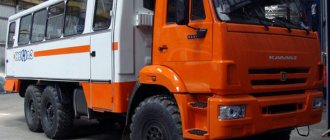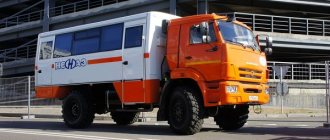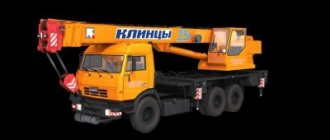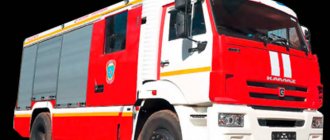Daniil Minaev, photo by the author
Recently, the Russian state postal service received a large shipment of vans on the KAMAZ-65117 chassis. This fact allowed me to contact the press service of the Russian Post in order to get acquainted with one of these machines.
My first acquaintance with the similar KAMAZ-65115 took place in 2004 and almost ended in “failure”. The logistics company where I worked at that time purchased the first three chassis of this model that ended up in Moscow for the installation of postal vans. I drove one of them from a car dealership to our parking lot. The area where the machines were stored was quite cramped, with narrow passages between the production buildings. Having made a dashing turn, I see in the mirror the corner of the building rapidly approaching. Stop!
I go out and start looking, how come I don’t fit in so well? When I drove KAMAZ-53212 before, such problems did not arise... And then I understand that in that “53212” the rear bogie began almost immediately after the gas tank, but here in the base you can place a couple more tanks... Yes, this is a completely different KAMAZ! According to factory data, chassis 65115 is produced in three wheelbase options: 3190, 3690 or 4470 mm, and for model 65117 two wheelbase options are available: 3690 or 4970 mm. The distance between the axles of the rear bogie is always 1320 mm.
Isothermal van 47415E (KAMAZ-4308 4x2 chassis)
The 47415E van is designed for the transportation of various household goods, including perishables and consumer goods. Options for making a campervan:
- manufactured goods van: outer skin - determines the type of van: a) galvanized sheet 0.8 mm (coated and uncoated); b) clad; c) polymer; d) plywood; Internal cladding with 4 or 6 mm plywood is possible, the floor is painted steel; platform - steel lattice frame with flooring made of FSF-27 plywood;
- the isothermal van is a modification of the manufactured goods analogue, the walls and roof are lined with 50 mm thick foam plastic and lined with an internal lining made of 0.55 mm galvanized sheet;
- isothermal from sandwich panels: outer cladding: a) galvanized sheet 0.8 mm; b) clad metal; c) galvanized sheet 0.8 mm + polymer; d) laminated plywood; e) 1.2 mm plastic on FK-4 plywood; f) clad aluminum; g) stainless steel 0.8 mm; internal cladding - panels made of galvanized sheet 0.55 mm; plastic 1.2 on FK-4 plywood.
According to the degree of isothermality, vans are manufactured in 3 types:
- low isothermal: platform panel thickness - 80 mm; side walls, front wall, doors and roof - 40 mm;
- medium isothermal: platform panel thickness - 80 mm; side walls - 40 mm; front wall, doors and roof - 60 mm;
- high isothermal: platform panel thickness - 100 mm; side walls - 60 mm; front wall, doors and roof - 80 mm.
Star Song
This is sometimes called life circumstances associated with some repetition of the events of youth or simply pleasant memories. Here I am again driving along the M7 highway to Vladimir to look at the new KAMAZ-65117 in detail, and 11 years ago in a brand new van along this very highway we were laying a new Ural postal route on the related KAMAZ-65115.
The first thing I noticed was the suspiciously quiet operation of the engine at idle, and the tonality was not entirely familiar. And the engine, it turns out, is Cummins! In-line, 6-cylinder, displacement 6.7 liters. Behind it, a 9-speed ZF gearbox was hidden under a plastic casing. This is what can hide the familiar appearance of a long-familiar truck. In general, according to tradition, I’ll start looking for differences in the new model from the driver’s workplace.
Transmission and chassis
The torque from the engine is transmitted to a mechanical 9-speed gearbox ZF Ecomid 9S1310TO, which, as already mentioned, is “homemade” at the TsF-KAMA joint venture. Single disc clutch with diaphragm spring. The power line is continued by the rear drive axles on the usual balancing trolley, on two ten-leaf springs with sliding rear ends and reaction rods. The middle bridge is a passage bridge. The gear ratio of the main pair is 5.94. The driveshaft connections are now with end splines, which seriously reduce the load on the fasteners, as in most modern cars. The brakes on all wheels are still drum brakes, but with a diameter of 400 mm, and the width of the working surface of the brake pads is 140 mm, and there is also an anti-lock braking system. The steering mechanism is imported - RBL, thanks to the increased working pressure, which made it possible to reduce the force on the steering wheel when driving at low speeds. The wheels are tubeless, size 11R22.5.
Technical characteristics of the AF-47415N van on the KAMAZ-65117A4 chassis
| Total weight, kg | 24 000 |
| Permissible axle load, kg | 6000/ 9000/ 9000 |
| Chassis curb weight, kg | 10 600 |
| Chassis load capacity, kg | 13 400 |
| Permissible total weight of the road train, kg | 38 000 |
Engine
| Cummins 6ISBe4 300, turbodiesel I-6, Euro 4 6960 298 at 2500 min-1 1097 at 1400 min-1 |
Transmission
| ZF Ecomid 9S1310TO, mechanical 9/1 |
| Clutch | Dry, single disc |
| Braking mechanisms of all wheels | Drum, diameter 400 mm |
| Fuel tank capacity, l | 500 |
| Front suspension | Leaf springs |
| Rear suspension | Spring-balanced |
| Tires | KAMA NF701, 11R22.5 |
Diesel for 24 t gross weight
A widespread modern trend is that in-line six-cylinder diesel engines are gradually replacing heavy and low-power V-shaped eights of outdated design. The scope of application of modern V-engines today has shifted towards higher gross weights of vehicles and special equipment. This trend has also reached Naberezhnye Chelny, where Cummins was chosen as a strategic partner. However, occasional facts of cooperation between the Chelny auto giant and the Cummins corporation have been known for a couple of decades. Cummins diesel engines of the ISB series are in-line 4- and 6-cylinder engines with power ranging from 110 to 300 hp. and a working volume of 4.5 or 6.7 liters, as in our case.
The motors of this series are equipped with an electronic control unit that allows you to program parameters according to the necessary requirements. Electronic Data Protocol – SAE J1939 and J1587. The cylinder block of the ISB series engines does not have liners and is designed specifically to reduce oil consumption due to waste and reduce noise levels. These engines are equipped with a Holset turbocharger, which improves torque characteristics at low speeds. Fuel system - Common Rail. The cylinder head is single, 24-valve. The drive of auxiliary units and the camshaft is made from the flywheel side. Engines of this series are easy to maintain. According to the factory instructions, valve adjustment is provided after 200,000 km, and oil change intervals up to 40,000 km when using ACEA E5 class oils.
House under the starry sky
I remembered how at the end of 2004 I was caught in heavy snow just as I was going around Vladimir. The southern bypass of the city, which is in operation today, had not yet been fully put into operation, and transit traffic passed through the village of Bogolyubovo, famous for the beautiful monastery located right along the highway. Impenetrable darkness, the darkness is cut by a beam of headlights, snow and wind, flakes fly onto the windshield, and on the right, golden domes against the black sky reflect the light of the headlights. Unforgettable beauty!
The old car already had a one-piece windshield, but there were only two wiper arms, like on the earlier version with a windshield made of two halves. Because of this, the central part of the glass did not fall into the working area of the wipers, making it difficult to see. In the blue cab of the 2015 KAMAZ-65117, everything is as it should be: three leashes and several modes of operation of the windshield wipers. Heated mirrors have also been added, and there are now plenty of mirrors themselves; there is even a “curb” sphere on the right side of the remote rack. The only pity is that the cockpit glass area is still too small. But the new front panel made of plastic has seriously modernized the interior.
Continuing to study the buttons on the center console, I noted the presence of a heated fuel tank and an inter-wheel lock. The driver's seat is made by Grammer with fabric upholstery and spring suspension, and in the overhead console above the driver's head there is a VDO digital tachograph. The gear shift lever has lost its usual “flag” - the licensed “nine-speed” ZF, manufactured in Naberezhnye Chelny, has its own shift algorithm. On the left of the dashboard is the Webasto liquid autonomy control panel. The instrument cluster is now of a block type, supplied by ELARA OJSC from Cheboksary, and has a self-diagnosis function. The accelerator pedal has become electronic, suspended type, the driver’s right foot no longer falls into the “trap”. The sleeping area remained unchanged, except that new finishing materials improved heat and sound insulation. The mounting of the cab has not changed fundamentally: it is rigid in the front, and on simple shock absorber struts in the rear. But we should not forget that today a new family of trucks with a fundamentally different cab is being produced in Chelny, so the KAMAZ buyer still has a choice.
Van specifics
The specifics of postal transportation presuppose its own requirements for the cargo compartment (“GP” No. 7, 2013). First of all, the van must be absolutely sealed - leaks are not allowed even in the heaviest rainfall. The inside walls are lined with plywood, and thermal insulation material is laid between the outer panels. The surfaces of walls, floors and ceilings should not have sharp or protruding parts in order to prevent damage to consolidated cargo of the most varied and unpredictable nature. There is interior lighting and a door opening alarm system. The state postal van also has special flashing lights. The Ryazan LLC TSENTRTRANSTEKHMASH successfully completed the task set by the postal workers to produce such a van.
The editors thank the press service of the Federal State Unitary Enterprise "Russian Post" for their assistance in preparing the material.


